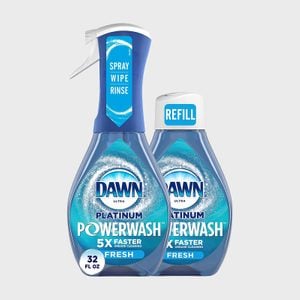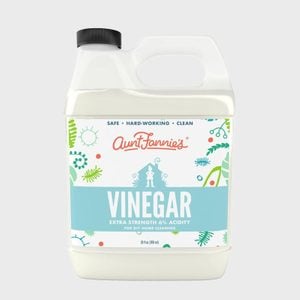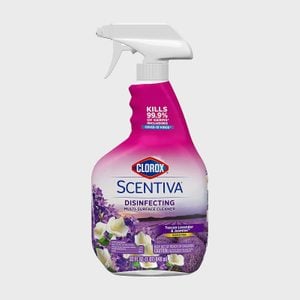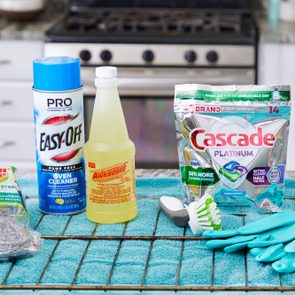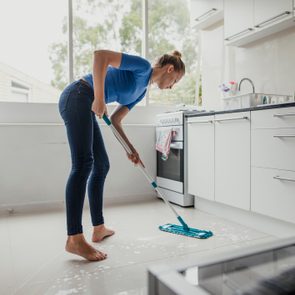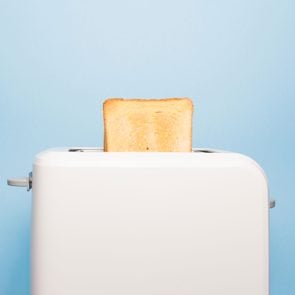How to Clean Kitchen Cabinets Inside and Out
Updated: Apr. 19, 2024

Beautiful kitchen cabinets really catch the eye—and just about everything that splatters, smears or spills. Here's how to clean kitchen cabinets like a pro.
Kitchen cabinets do more than hold dishes, pots, pans and all of your groceries. They hold dirt … and drips … and enough grease to fry a chicken. Yuck! To help you deal with these mess magnets, we asked two top cleaning pros, Vera Peterson, president of Molly Maid, and Mary Gagliardi, a stain and cleaning expert with Clorox dubbed “Dr. Laundry,” to give us the scoop on how to clean kitchen cabinets. Whether yours are made of finished wood, painted wood, vinyl, plastic or laminate, they’ve got you covered.
Plus, they’ll share their cleaning schedules and favorite tips for cleaning kitchen cabinets like a pro. You’ll appreciate Gagliardi’s unique insight into cleaning products, especially if disinfecting is your top priority. “When the protective finish on your cabinets is in good condition, even bleach and water can be appropriate for cleaning kitchen cabinets,” she says. And you’ll want to take Peterson’s commonsense approach to heart: “We recommend doing one cabinet at a time to prevent being overwhelmed,” she says.
Read on for more sage advice from these cleaning dynamos as they explain how to clean kitchen cabinets until they’re good as new. And while you’re tidying up, give the rest of your cooking space a scrub-down—clean that germy kitchen sink, sanitize your wooden cutting boards and go to town on your stained and splattered gas stovetop.
Get Reader’s Digest’s Read Up newsletter for more cleaning, humor, travel, tech and fun facts all week long.
On This Page
How to clean kitchen cabinets
Whether you need to know how to clean painted cabinets or how to clean wood cabinets in their natural state, you’ve come to the right place. Our experts are here to tell you all about it, including how to clean sticky grease off kitchen cabinets. Let’s start with cleaning products and supplies. Peterson favors DIY cleaners, while Gagliardi opts for name brands (like Clorox, naturally).
Here’s a list of their combined preferences. Use what works best for your needs and priorities.
Supplies
- Water
- White vinegar
- Rubbing alcohol
- Dish soap
- Baking soda
- Spray bottle
- Microfiber cloth
- Toothbrush
- Sponge
- Spatula
- Bucket
- Glass cleaner
- Multi-surface cleaner
- Vacuum with a hose attachment (optional)
1. Gather your tools
Before you start cleaning, determine which supplies you’ll use to take your cabinets from grimy to good as new. Choosing the appropriate cleaning product and tools will help you avoid damaging the finish on your cabinets.
If you like DIY cleaners, try one of these:
- All cabinet types: Mix 2 teaspoons of mild dishwashing liquid (like Dawn) into a gallon of warm water.
- Laminate cabinets: Mix equal parts alcohol and warm water in a spray bottle.
- All cabinet materials except laminate: Mix equal parts white vinegar and warm water in a spray bottle.
- Extra-greasy cabinets: Add a few drops of dishwashing liquid to the alcohol or vinegar solutions above.
If you prefer to use a commercial product, both multi-surface cleaners and disinfecting wipes work well. But follow the pros’ rule: If you’re using a new cleaner, test it first in an inconspicuous spot to make sure it doesn’t damage your cabinets’ finish.
2. Clean the top of the cabinet
Your cleaning process should take gravity into account, and that’s true whether you’re cleaning kitchen cabinets, wiping down your walls or dusting your whole house. As you clean your cabinets, dust and dirt are going to fall down. That’s why it’s smart to start high.
Begin by vacuuming the tops of the cabinet doors. If your cabinets do not reach the ceiling, you’ll have to clean the dusty cabinet tops too. A vacuum with a hose attachment or a microfiber cloth easily removes this dust. If the dust is mixed with grease, scrape it off with an old credit card or a hard plastic spatula.
Spray the surface with a mixture of equal parts white vinegar and warm water or a multi-surface cleaner. Allow it to work for a minute or two, then wipe it with a clean cloth. Repeat as needed.
3. Clean inside the cabinet
Empty the cabinet, moving all of your glassware, dishes and other kitchen items to a dust-free location. Vacuum or wipe the inside of the cabinet to remove dust and food particles.
4. Wipe down the cabinet’s exterior
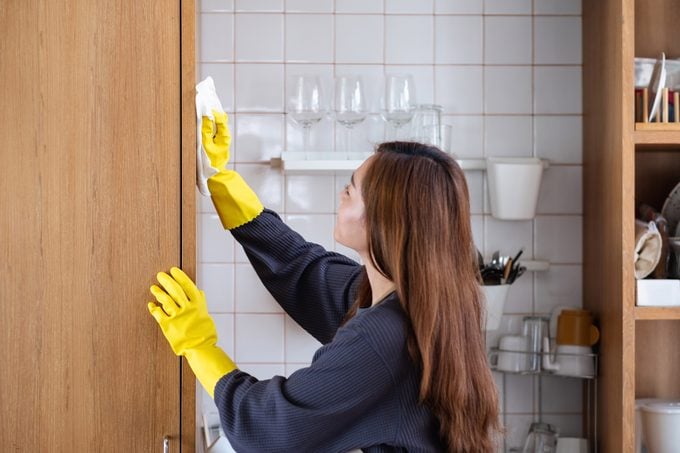
Lightly spray or wipe the outside of the cabinet doors with the cleaning solution. Allow it to sit for a minute or two, then wipe it with a microfiber cloth.
You don’t want that cleaning solution sitting on your cabinets, so rinse them off with a damp cloth. Repeat the process to remove stubborn grease and spots.
5. Clean knobs and drawer pulls
Knobs, handles and drawer pulls are the most frequently touched items on cabinets, so give them some extra love while you’re wiping down doors and drawers. To clean dust and grime from those hard-to-reach nooks and crannies, use a toothbrush or a cotton swab dipped in the cleaning solution. But take care: If your hardware is made of metals like copper, brass or silver, it can require special care.
Once you’ve given them a good scrub, rinse off the cleaning-solution residue with a soft cloth dipped in clean water. Dry the hardware with a clean cloth.
6. Clean the hinges
This is probably the easiest step to overlook, but it’s important. Clean the cabinet’s hinges with a dry microfiber cloth, or use a toothbrush to get rid of stuck-on gunk. If you need extra cleaning power, add a dot of cleaning product to the cloth and wipe the hinge. Rinse with a damp cloth, then dry thoroughly.
7. Clean the cabinet doors and shelves
Spray the inside of the doors and the shelves with the cleaning solution. Allow it to sit for a minute or two before wiping the inside surfaces with a microfiber cloth. Don’t forget to rinse with a damp cloth.
Take extra care with cabinets that have glass doors; you don’t want the glass-cleaning solution to drip onto the woodwork and stain it. Spray a clean cloth—not the glass—with a vinegar-and-water solution or a commercial glass cleaner. Wipe the glass doors both inside and out.
8. Get rid of stains
To remove stubborn stains, make a paste using two parts baking soda and one part water. Apply it to the stain. Wait two to three minutes, then gently wipe the area. Baking soda is abrasive, so use a light touch. After, rinse with a lightly dampened cloth.
9. Dry thoroughly
Dry all surfaces thoroughly with a clean microfiber cloth. Want your cabinet to really shine? Grab another soft cloth and use it to buff the surface. If it still looks dull, try using beeswax polish or a kitchen cabinet cream to restore the sheen. If that fails to do the trick, you may need to remove product buildup.
Leave the cabinet doors open for an hour or two to allow the areas you cleaned to dry completely. After that, you can restock your cabinets.
The best kitchen cabinet cleaners
Peterson’s go-to supplies are natural cleaning products you probably already have on hand—think dish detergent, rubbing alcohol and white vinegar. As Clorox’s Dr. Laundry, Gagliardi gravitates toward multipurpose cleaners.
How to keep kitchen cabinets clean
After all that hard work, you’re going to want to keep your freshly scrubbed kitchen cabinets nice and clean. While dust and grease buildup are inevitable, the steps below will help you stretch the time between deep cleanings.
- Never leave your cabinet doors open; grab what you need, then immediately close them. That’s the best way to keep the interiors of your kitchen cabinets clean.
- Doors and drawers that do not close completely are a magnet for grease and dirt. Fix the hinges and drawer glides to remedy the problem.
- To reduce grease on cabinets, use a splatter screen and turn on the exhaust fan when frying.
- Keep shelves clean by using shelf liners and wiping bottles and jars before returning them to the cabinet.
- Clean spills immediately. When cleaning your countertops, make sure food or other gunk hasn’t dripped onto the bottom cabinets; if it has, clean it up quickly. Wipe smears and fingerprints off cabinets ASAP.
- Recycle old face cloths, turning them into kitchen towels. Use them to wipe your hands as you cook so you don’t transfer food to your cabinets or drawers.
How often should you clean kitchen cabinets?
How often you clean your kitchen cabinets depends on how often you cook and how frequently you fry foods in oil.
If you regularly cook in your kitchen, you’ll want to wipe down the outside of your cabinets and drawers once a week or at least every other week. They should be deep cleaned (cleaned inside and out) every three to 12 months, depending on how dirty they are. Regularly cook with oil? You’ll need to deep clean the cabinets in the cooking area even more frequently.
If you order take-out more than you cook, you can clean the outside of your cabinets and drawers every one or two months. Clean the inside and outside of cabinets and drawers once a year.
Pro kitchen cabinet cleaning tips to keep in mind
We didn’t just ask the experts how to clean kitchen cabinets. We also asked for their top cleaning tips, and boy did they deliver.
- Don’t try to clean all of your cabinets at once. It’s overwhelming. Instead, tackle one at a time.
- Wood and water do not mix. When cleaning wood cabinets, make sure the finish is in good condition. If not, use only slightly dampened cloths for cleaning and rinsing. Do not allow liquid to sit on the wood, and dry surfaces thoroughly after rinsing.
- Do not use any products that contain ammonia, bleach, solvents, strong detergents or soaps, nail polish remover or paint thinner. Stay away from plastic brushes, steel wool and scouring pads. All of these products and tools can strip the wood and paint finish and damage your cabinets.
- Do not use white erasers or melamine sponges on finished wood. They are abrasive and could scratch the finish.
- Keep kitchen wipes handy for quick cabinet cleanups. You’re more likely to clean when you have something nearby that’s fast and easy to use.
- Do not use vinegar or baking soda on laminate cabinets.
- In general, when cleaning anything in your home, you should not mix ammonia and bleach, vinegar and bleach, rubbing alcohol and bleach, or vinegar and hydrogen peroxide.
- If you aren’t sure if a cleaning product is appropriate for your cabinets, test the product you want to use in a hidden area first.
- Make sure you wipe the tops of cabinets and cabinet doors to remove dust and grease.
- Probably the most overlooked place to clean is the kick plate under the base cabinets. Wipe it down when you deep clean cabinets. You’ll be surprised at what gets stuck on it!
Sources:
- Vera Peterson, president of Molly Maid
- Mary Gagliardi, aka Dr. Laundry, a stain expert with Clorox




















